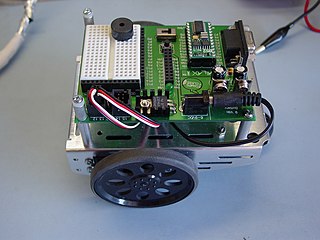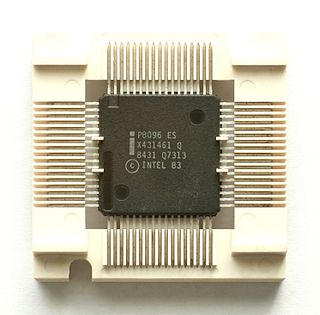
The BASIC Stamp is a microcontroller with a small, specialized BASIC interpreter (PBASIC) built into ROM. It is made by Parallax, Inc. and has been popular with electronics hobbyists since the early 1990s.

The BASIC Stamp is a microcontroller with a small, specialized BASIC interpreter (PBASIC) built into ROM. It is made by Parallax, Inc. and has been popular with electronics hobbyists since the early 1990s.
Although the BASIC Stamp 2 has the form of a 24 pin DIP chip, it is in fact a small printed circuit board (PCB) that contains the essential elements of a microprocessor system: [1]
The end result is that a hobbyist can connect a 9 V battery to a BASIC Stamp and have a complete system. A serial connection to a personal computer allows the programmer to download software to the BASIC Stamp, which is stored in the onboard non-volatile memory device: it remains programmed until it is erased or reprogrammed, even when the power of the stamp is removed. If the power is reconnected the stamp immediately starts executing the program in slot 0 (of 8, numbered 0..7).
The BASIC Stamp is programmed in a variant of the BASIC language, called PBASIC. PBASIC incorporates common microcontroller functions, including PWM, serial communications, I²C and 1-Wire communications, communications with common LCD driver circuits, hobby servo pulse trains, pseudo-sine wave frequencies, and the ability to time an RC circuit which may be used to detect an analog value.
Once a program has been written in the 'Stamp Editor', an integrated development environment (IDE) in Windows, the syntax can be checked, tokenized and sent to the chip through a serial/USB Mini-B cable, where it will run.

There are currently four variants of the interpreter:
The BS2 sub-variants feature more memory, higher execution speed, additional specialized PBASIC commands, extra I/O pins, etc., in comparison to the original BS2 model. While the BS1 and BS2 use a PIC, the remaining BASIC Stamp 2 variants use a Parallax SX processor.
The third variant is the Javelin Stamp. This module uses a subset of Sun Microsystems' Java programming language instead of Parallax's PBASIC. It does not include any networking facilities.
The fourth variant is the Spin Stamp. The module is based on the Parallax Propeller and therefore uses the SPIN programming language instead of PBASIC.
A number of companies now make "clones" of the BASIC Stamp with additional features, such as faster execution, analog-to-digital converters and hardware-based PWM which can run in the background.
The Parallax Propeller is gradually accumulating software libraries which give it functionality similar to the BASIC Stamp; however, there is no uniform list of which PBASIC facilities now have Spin equivalents. [2]

A microcontroller or microcontroller unit (MCU) is a small computer on a single integrated circuit. A microcontroller contains one or more CPUs along with memory and programmable input/output peripherals. Program memory in the form of NOR flash, OTP ROM, or ferroelectric RAM is also often included on the chip, as well as a small amount of RAM. Microcontrollers are designed for embedded applications, in contrast to the microprocessors used in personal computers or other general-purpose applications consisting of various discrete chips.

AVR is a family of microcontrollers developed since 1996 by Atmel, acquired by Microchip Technology in 2016. These are modified Harvard architecture 8-bit RISC single-chip microcontrollers. AVR was one of the first microcontroller families to use on-chip flash memory for program storage, as opposed to one-time programmable ROM, EPROM, or EEPROM used by other microcontrollers at the time.

PIC is a family of microcontrollers made by Microchip Technology, derived from the PIC1640 originally developed by General Instrument's Microelectronics Division. The name PIC initially referred to Peripheral Interface Controller, and is currently expanded as Programmable Intelligent Computer. The first parts of the family were available in 1976; by 2013 the company had shipped more than twelve billion individual parts, used in a wide variety of embedded systems.

The MSP430 is a mixed-signal microcontroller family from Texas Instruments, first introduced on 14 February 1992. Built around a 16-bit CPU, the MSP430 was designed for low power consumption, embedded applications and low cost.

The PIC16C84, PIC16F84 and PIC16F84A are 8-bit microcontrollers of which the PIC16C84 was the first introduced in 1993 and hailed as the first PIC microcontroller to feature a serial programming algorithm and EEPROM memory. It is a member of the PIC family of controllers, produced by Microchip Technology. The memory architecture makes use of bank switching. Software tools for assembler, debug and programming were only available for the Microsoft DOS and Windows operating systems.

The Zilog Z8 is a microcontroller architecture, originally introduced by Zilog in 1979. Today the line also includes the Z8 Encore!, eZ8 Encore!, eZ8 Encore! XP, and eZ8 Encore! MC families.
A general-purpose input/output (GPIO) is an uncommitted digital signal pin on an integrated circuit or electronic circuit board which may be used as an input or output, or both, and is controllable by software.
PBASIC is a microcontroller-based version of BASIC created by Parallax, Inc. in 1992.

PICAXE is a microcontroller system based on a range of Microchip PIC microcontrollers. PICAXE devices are Microchip PIC devices with pre-programmed firmware that enables bootloading of code directly from a PC, simplifying hobbyist embedded development. PICAXE devices have been produced by Revolution Education (Rev-Ed) since 1999.
The XGameStation is a series of embedded systems, primarily designed as a dedicated home video game console, created by Andre LaMothe and sold by his company Nurve Networks LLC. Originally designed to teach electronics and video game development to programmers, newer models concentrate more on logic design, multi-core programming, game programming, and embedded system design and programming with popular microcontrollers.
Parallax Inc. is a privately held company in Rocklin, California. Parallax Inc. designs, manufactures, and sells BASIC Stamp microcontrollers, Propeller microcontrollers, microcontroller accessories, educational robot kits, and educational curriculum.

BOE–Bot is short for Board of Education robot. It is the trade name of a robot kit that is used in junior high, high school and college robotics classes. It consists of a main circuit board and breadboard, a plug–in BASIC Stamp microcontroller, two servo motors to drive the wheels, and an aluminum chassis that the parts bolt onto. Students can use Erector set parts, Lego blocks, and additional servos to build custom projects. The BOE-bot has been manufactured and sold by Parallax Inc since 1998.

The Parallax P8X32A Propeller is a multi-core processor parallel computer architecture microcontroller chip with eight 32-bit reduced instruction set computer (RISC) central processing unit (CPU) cores. Introduced in 2006, it is designed and sold by Parallax, Inc.
MIDIbox is a non-commercial open source project with a series of guides on how to build musical instrument device interfaces (MIDI). Through a series of do it yourself tutorials, users are guided in the process of building a basic microcontroller that can also be used to build hardware MIDI control units for various synthesizers, multi-track recording software, and other MIDI devices; as well as stand-alone synthesizers, sequencers and other projects.

The Intel MCS-96 is a family of microcontrollers (MCU) commonly used in embedded systems. The family is often referred to as the 8xC196 family, or 80196, the most popular MCU in the family. These MCUs are commonly used in hard disk drives, modems, printers, pattern recognition and motor control. In 2007, Intel announced the discontinuance of the entire MCS-96 family of microcontrollers. Intel noted that "There are no direct replacements for these components and a redesign will most likely be necessary."
Parallax SX is a discontinued line of microcontrollers that was marketed by Parallax, from a design by Ubicom. Designed to be architecturally similar to the PIC microcontrollers used in the original versions of the BASIC Stamp, SX microcontrollers replaced the PIC in several subsequent versions of that product.

A single-board microcontroller is a microcontroller built onto a single printed circuit board. This board provides all of the circuitry necessary for a useful control task: a microprocessor, I/O circuits, a clock generator, RAM, stored program memory and any necessary support ICs. The intention is that the board is immediately useful to an application developer, without requiring them to spend time and effort to develop controller hardware.
The following outline is provided as an overview of and topical guide to electronics:

The Arduino Uno is an open-source microcontroller board based on the Microchip ATmega328P microcontroller (MCU) and developed by Arduino.cc and initially released in 2010. The microcontroller board is equipped with sets of digital and analog input/output (I/O) pins that may be interfaced to various expansion boards (shields) and other circuits. The board has 14 digital I/O pins, 6 analog I/O pins, and is programmable with the Arduino IDE, via a type B USB cable. It can be powered by a USB cable or a barrel connector that accepts voltages between 7 and 20 volts, such as a rectangular 9-volt battery. It has the same microcontroller as the Arduino Nano board, and the same headers as the Leonardo board. The hardware reference design is distributed under a Creative Commons Attribution Share-Alike 2.5 license and is available on the Arduino website. Layout and production files for some versions of the hardware are also available.

The Proteus Design Suite is a proprietary software tool suite used primarily for electronic design automation. The software is used mainly by electronic design engineers and technicians to create schematics and electronic prints for manufacturing printed circuit boards.